#southern racism
Text

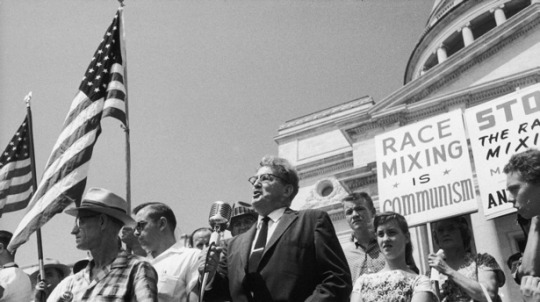
It took LaToysha Brown 13 years to realize how little interaction she had with white peers in her Mississippi Delta town: not at church, not at school, not at anywhere.
The realization dawned when she was in the seventh grade, studying the civil rights movement at an after-school program called the Sunflower County Freedom Project. It didn't bother her at first. By high school, however, Brown had started to wonder if separate could ever be equal. She attended a nearly all-black high school with dangerous sinkholes in the courtyard, spotty Internet access in the classrooms, and a shortage of textbooks all around. Brown had never been inside Indianola Academy, the private school most of the town's white teenagers attend. But she sensed that the students there had books they could take home and walkways free of sinkholes.
"The schools would achieve so much more if they would combine," said Brown, now age 17 and a junior.
But more than four decades after they were established, "segregation academies" in Mississippi towns like Indianola continue to define nearly every aspect of community life. Hundreds of these schools opened across the country in the 20 years after the Brown v. Board decision, particularly in southern states like Mississippi, Arkansas, Alabama, and Virginia. While an unknown number endure outside of Mississippi, the Delta remains their strongest bastion.
A Hechinger Report analysis of private school demographics (using data compiled on the National Center for Education Statistics website) found that more than 35 such academies survive in Mississippi, many of them in rural Delta communities like Indianola. Each of the schools was founded between 1964 and 1972 in response to anticipated or actual desegregation orders, and all of them enroll fewer than two percent black students. (The number of Mississippi "segregation academies" swells well above 35 if schools where the black enrollment is between three and 10 percent are counted.) At some of them -- including Benton Academy near Yazoo City and Carroll Academy near Greenwood -- not a single black student attended in 2010, according to the most recent data. Others, like Indianola Academy, have a small amount of diversity.
Recommended Reading
"These schools were started to keep white children away from blacks," said Wade Overstreet, a Mississippi native and the program coordinator at the national advocacy organization Parents for Public Schools. "They've done an amazing job of it."
It would be easy to see Indianola -- and Mississippi more generally -- as an anomaly when it comes to education: hyper-segregated, fraught with racial mistrust, stuck in the past. But in some respects, the story of education in Indianola is becoming the story of education in America.
As the Atlantic reported last week, throughout the country, public schools are nearly as segregated as they were in the late 1960s when Indianola Academy opened. In many areas, they are rapidly resegregating as federal desegregation orders end. White families continue to flee schools following large influxes of poor or minority students. And in Indianola, as in the rest of the country, there's stark disagreement as to why: Whites often cite concerns over school quality, while blacks are more likely to cite the persistence of racism.
Indeed, as Indianola struggles to make its way educationally and economically in the 21st century, the town's experience serves as a cautionary tale of how separate and unequal schools can not only divide a community, but fracture a place so deeply that its very existence is at stake.
Flight From Gentry
Indianola's tale of two school systems -- one public and black, one private and white -- began in January of 1970, when a U.S. district judge ruled that Indianola could no longer permit blatant segregation in its public school system. For years, white students had attended schools north of the train tracks that divide the town, while black students were relegated to inferior school buildings south of the tracks. The plan was to merge the schools and send all high school students -- white and black -- to the previously black Gentry High School.
In anticipation of the ruling, the white community founded Indianola Academy in 1965. But the fledgling school did not yet have a facility large enough to accommodate the hundreds of white students who left the public schools during Christmas break in 1969, knowing the decision was imminent, said Steve Rosenthal, a senior in high school at the time. Rosenthal said he was instructed to bring his textbooks home with him over break. When school started back up in January, he attended one of the academy's new satellite campuses in a Baptist church. The situation was far from ideal: Study halls sometimes were interrupted by weekday funerals. Yet not a single white student showed up at Gentry that semester. In the spring, Rosenthal received his diploma as part of the academy's first graduating class.
Today, Rosenthal serves as mayor of Indianola, a two-hour drive north of Jackson. The academy still thrives. According to the Private School Universe Survey, the school enrolled 434 white students and two black ones during the 2009-10 school year (the most recent year for which such data is available). Yet fewer than 20 percent of the town's approximately 10,000 residents are white.
Little else is publicly known about Indianola Academy apart from the information the school promulgates on its website. As a private school, its students do not have to take the state's standardized tests (much to the chagrin of the town's public school students), though a student handbook on the school's website states that students should score in the top 30 percent on a student achievement test to gain admission.
Sammy Henderson, the academy's headmaster, never responded to a reporter's request to visit while in town. But he did answer several questions via e-mail. Henderson wrote that African-American enrollment at the school has risen to nine students this school year, and "we also have Hispanic, Indian, and Oriental students." Annual tuition, which includes money for books and other fees, ranges from $3,795 to $5,080, depending on the grade level. And the academy budgets money annually for minority scholarships, spreading word about their availability via newspaper advertisements and word-of-mouth, Henderson said.
IRS tax forms filed by Indianola Academy show the school has raised a modest amount for scholarships in recent years. In 2010, for instance, the school paid out $6,500 for "minority scholarships," according to those forms.
Tradition and history partly explain why the scholarships aren't more widely utilized: Black families know their children could be isolated and shunned at the academy, and those with the means and desire to avoid the public schools have long relied on other -- more historically welcoming -- private schools, including a tiny, nearly all-black Christian academy in Indianola.
But Indianola Academy is also highly selective and opaque in its recruitment and admissions processes for African-Americans, according to public school students and teachers. Applicants have to be top students and submit multiple letters of recommendation, said a Sunflower County Freedom Project participant whose younger brother thought about applying. And some black students appear to be recruited at least partly because of their athletic abilities, said Sam Wallis, a current Gentry teacher, and Katie Cooney, a former one. Henderson denies that claim, writing that several of the academy's African-American students do not even play sports. He said a "minority scholarship committee" reviews the applications and awards money to those who "meet the qualifications," although he did not spell out what those qualifications are.
The academy, like other private schools, is eligible for federal money through what are known as Title programs that flow through public school districts. Indianola school district officials say the academy has received about $56,000 in Title II money for professional development over the last two years.
But apart from that exchange of money, there's little formal or informal interaction between the academy and the public school system, say Indianola residents.
Wallis, a New York native who attended public schools in Westchester County, expected to encounter segregation when he moved to Indianola in 2011 to teach in the public schools. But he had not anticipated such a laissez-faire attitude toward it.
"When I taught Plessy v. Ferguson, I offered it up that separate is not equal. I said it was one of the worst decisions in American history," he said. "But several of the students said, 'Why? That sounds okay.'"
Sinkholes and Low Scores
Compared to Indianola Academy, Gentry High School is an open book, its academic struggles exposed to the world. While there's some modest racial integration at Indianola's public elementary schools, by high school all but a few white students have departed. Ninety-eight percent of Gentry's students are black, one percent are Hispanic, and one percent are white. A plaque at the school's entrance states that Gentry was erected in 1952 as part of South Sunflower County's "special consolidated school district for colored."
The campus is made up of several worn buildings, which means that students have to walk outdoors between many of their classes. Since the outdoor drainage and sewage systems are outdated, sinkholes dot the walkways; when it rains, students and teachers can find themselves wading through foot-deep floodwaters.
Even Gentry's current students believe white county leaders deliberately built a partially outdoors campus 60 years ago, after a fire destroyed the previous school building, because they hoped it would deter black students from coming to school in the rain or cold. "They didn't want black kids to get an education," said Brown.
Gentry has struggled with test scores since the state's accountability system began in the 1990s: Last year, 56 percent of students at the school had passing scores in algebra, 51 percent in English, 42 percent in history, and 17 percent in biology.
But students like Brown believe the poor scores are at least partly because the school lacks the resources it needs to be successful. Students sometimes swelter in classrooms without working air-conditioning during the hottest months and they can shiver without enough heat during the coldest. In some classes, the teenagers cannot take textbooks home because teachers fear they will get lost. Computers crash constantly because of low bandwidth. In Wallis' first year at Gentry (2011-12), he inherited government textbooks identifying the latest U.S. president as George H.W. Bush.
"The school needs to be torn down and rebuilt altogether," says Brown.
Her classmate, 16-year-old Primus Apolonio, says poorly behaved students also keep Gentry down -- partly by scaring away the teachers. Of the six young instructors brought to Gentry in the fall of 2011 through the alternative recruitment program, Teach For America, Wallis was the only one to return for a second year. Others left for personal reasons, or because of frustration with the job, according to Gentry staff. Teach for America participants typically make two-year commitments to teach in a high-needs school.
"The students are disrespectful to the point where the teachers don't stay," said Apolonio. "And the school [administration] does not do anything but paddle them and send them back to class." (Corporal punishment has long been legally employed by Indianola's school district staff, as in other parts of the state. Earl Watkins, the "conservator" recently appointed by the state to oversee the school district, wrote in an e-mail that teachers have also been trained in other discipline strategies. "Because corporal punishment has been a practice for many years in the district, professional development must precede the reduction/phase-out of it," Watkins wrote.)
But Apolonio agrees with Brown that students would behave better if they felt like the community placed more value on their education. "During the winter it gets cold and the heaters don't work in the classrooms," he said. "Of course the kids are going to get more disruptive."
Gentry and Indianola Academy do not play each other in interscholastic sports; academies typically play other academies. Yet throughout most its history -- and for reasons that remain the subject of urban legend in town -- Indianola Academy has maintained control of a large football field adjacent to the old public junior high school (which now houses the district's early childhood center), on land town leaders say is actually privately owned by the American Legion. Instead of sharing the field, the academy leaders put their logo, IA, on the buildings like territorial markings. There's also a six-foot barbed wire fence around the field's perimeter: a stark reminder that outsiders should stay away.
Two Communities, Two Narratives
Indianola, like other segregated communities across the country, is defined not only by two school systems and two sides of town, but by two competing narratives that attempt to explain segregation's stubborn persistence.
According to one narrative, white leaders and residents starved the public schools of necessary resources after decamping for the academy, an institution perpetuated by racism. According to the opposing narrative, malfeasance and inept leadership contributed to the downfall of the public schools, whose continued failings keep the academy system alive.
Hury Minniefield is a purveyor of the former narrative. He was one of the first black students to integrate the town's public schools in 1967 through a voluntary -- and extremely limited -- desegregation program. He and his two younger brothers spent a single academic year at one of the town's white schools. "Because the blacks were so few in number, we didn't interfere with the white students too much and never did hear the 'n word' too much," he said.
Despite his unique personal history, Minniefield does not believe the schools in Indianola will ever truly integrate. "It has not been achieved and it will likely never be achieved," he said. "It's because of the mental resistance of Caucasians against integrating with blacks. ... Until the white race can see their former slaves as equals, it will not happen."
Steve Rosenthal, the mayor, takes a different view. He argues that many white families have no problem sending their children to school with black students, but choose Indianola Academy because the public schools are inferior. His two children, both in their 20s, graduated from the academy, where he believes they received a strong education. "I would not have had a problem sending them to public schools had the quality been what I wanted," he said, adding a few minutes later, "If there's mistrust, it's the black community toward the whites."
Rosenthal and Minniefield also have divergent views on what led to the public schools' decline.
The white community "would prefer not to pay a dime to the public schools," said Minniefield. "It's had a devastating effect on resources and the upward mobility of the community."
Rosenthal is not deaf to such arguments, agreeing that the Gentry campus should be updated or replaced. However, he cites mismanagement as well. When the state took over the schools in 2009, the district reportedly employed dozens of unnecessary employees, he says. "The old saying was that even the secretaries had secretaries," he said. "I don't think funding was our entire problem."
Students tend to offer the most nuanced perspective on why wholesale segregation endures. "It's because of both races," said Brown. "No one wants to break that boundary or cross that line. Both sides are afraid."
The Academies' Local Impact
The private academies scattered throughout the state have more in common than racial demographics and founding purpose. Many of them, like Indianola Academy, are located on their town's "Academy Drive" and embrace mascots that hearken back to the Civil War: the Generals, the Patriots, the Colonels. Their websites often prominently display non-discrimination clauses -- yet feature photos only of smiling white children.
The academies are also partly responsible for destroying the economic and educational fortunes of their communities, contends Dick Molpus, a former Mississippi secretary of state who co-founded Parents for Public Schools.
Those communities that continue to operate two separate school systems "are moving onto life support if they are not already dead," he said. "Companies don't want to come to places where both of the school systems are inferior." Molpus added that Mississippi towns have limited amounts of money, power, and influence. "When those three things are divided between black public schools and white academies, both offer substandard education," he said.
Richard Kahlenberg, a senior fellow at The Century Foundation and expert on school desegregation, said he's concerned that increasing numbers of poor, minority students will attend under-resourced schools nationally if segregation continues to deepen. Although research has uncovered blatant racial disparities in school spending, Kahlenberg defines school "resources" more broadly -- including teacher quality, parent involvement and peer college aspirations -- all of which he says tend to lag at schools with predominantly low-income, minority students.
'We Would Give Away Our Empty Buildings'
Rosenthal maintains that Indianola Academy, at least, offers a superior education. But he, too, is worried about the town's economic future. The schools aren't preparing enough students for living wage jobs, and the jobs aren't always there for those who need them. Indianola has lost several major businesses in recent decades, including the yard equipment manufacturer Modern Line and a large catfish processing plant. The town's population dropped by about 1,400, or 11.5 percent, between the 2000 and 2010 census. "We would give away our empty buildings to a company that would agree to employ x number of people," said Rosenthal.
Indianola's students say they need more than jobs to entice them to stay in a town that feels provincial in more ways than one. "Indianola is small to me," said Apolonio. "I would bring my family back here and show them where I grew up. But as far as living here? No."
Brown said the community has been taking small steps forward. Earlier this year the Sunflower Freedom Project published a literary magazine featuring the work of both public school and academy students -- an unprecedented collaborative effort. Hundreds of blacks now live north of the train tracks in previously all-white neighborhoods. And youth of different races meet regularly in recreational sports leagues, if not yet at formal interscholastic events.
Brown, however, would prefer to live in a town where the milestones are not so modest, the racial divide not so deep. "I do want to give back to this community," she said. "But if I start a family I do not want to start it here. We are so behind on everything -- especially education."
Jackie Mader contributed material to this report.
#In Southern Towns#'Segregation Academies' Are Still Going Strong#segregation academies#southern racism#segregation#nimrata haley
8 notes
·
View notes
Text

They'd push God aside to vote for Satan, as long as Satan was a white nationalist or a plant of the white nationalists. Their racism knows no bounds and Walker has no pride.
#raphael warnock#senator warnock#hershel walker#georgia elections#senate race#racist ass white people#racist republikkkans#racists#southern racism#southern narrative#us elections#2022 elections
6 notes
·
View notes
Text

1941
#history#vintage#awj cash#w.j. cash#writing#race relations#relations#american race#race#the south#south#southern racism#america#american history#american#20th century#20th century history#twentieth century#twentieth century history#aesthetic#aesthetics#literature#social#social history#1940s#1941#modern#modern writing#modern literature#modernism
1 note
·
View note
Text
youtube
This isn’t a comedy video this is a straight forward explanation of how the Republicans turned themselves around after Nixon by recruiting mainly southern racists. Then it explains how low-IQ Crooked Donald came along and was able to capture the hearts and minds of people as dumb as him. Speaking on a third grade level he appealed to the poorly educated and low IQ voters by appearing to be a successful version of them. He gave them a voice and they admire his ability to get away with virtually anything leading them to be unflappable members of his cult.
I highly recommend this 6 minute youtube video. It very plainly and succinctly explains the rise of the new Republican Party, post-Nixon, and the rise of Trumpism.
☝️
#explanation of the rise of Trumpism#post-Nixon Republican rebirth#southern strategy#bringing racism into politics#low IQ Donald appeals to the lowest common denominator amongst us#republican assholes#maga morons#republican hypocrisy#republican values#resist#republican family values#manipulation of the population#Lee Atwater#Steve Bannon#crooked donald#YouTube#six minute video
257 notes
·
View notes
Text


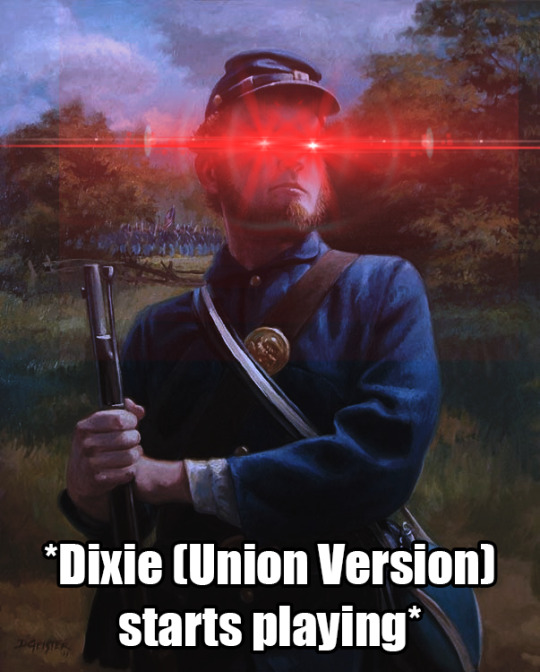

550 notes
·
View notes
Text
Song of The Day/history of cotton eyed joe
do you want the history of a folk song? dm me or submit an ask and I'll do a full rundown
youtube
"Cotton Eyed Joe"
Terry Callier, 1963
As a disclaimer, "Cotton Eyed Joe" is my least favorite American folk song and I'm going to talk about why, and I'm going to talk about why Terry Callier's version is subversive and good.
The Earliest date we have for the song's origins is from 1882 when it was Published in "Diddie, Dumps, and Tot, or, Plantation child-life" by Louise Clark-Pyrnelle. This book is a nostalgic recollection of her childhood as a plantation owner's daughter. She reminisces fondly about slavery, missing the old plantation days. Honestly, some of the quotes within this book are beyond parody, in one sentence she says "... My little book does not pretend to be any defense of slavery" and in the next sentence when referring to the morality of slavery she writes, "there are many pros and cons to that subject", later at the end of the chapter she laments about the forever lost emotional connection between the Masters children and the enslaved people. hate this woman and her little book.
It is also important to note that this book goes out of its way to caricature black people, throughout the book she exaggerates accents and dialects to dehumanize them. This is a recurring theme in early publications of this song.
Another early publication of the song comes from Dorothy Scarborough in "On the Trail of negro folk-songs" 1925 who got it from her sister who also learned it on a plantation, in Texas. She writes "This is an authentic slavery-time song" This book, if you can believe it, is remarkably racist and dismissive of black music, even as a more "progressive" songbook of black folk songs.
In 1922, the song's history was documented a bit more extensively by Thomas W. Talley in his book "Negro folk rhymes". He writes that it has "deep roots in black traditional lore". Thomas W. Talley was also just a cool guy in general, this book is one of the first compilations of African American folk songs, and it has been a pioneering book in its field. Even today, this book is still one of the best sources for the history of African American folk songs.


So, this is a black song. This was a black song whose first wave of popularization was through the caricature of black people to be amusing for white folks. Let's move on to its second wave of popularization.
The song was first recorded in 1927 by "Dykes Magic City Trio" (all white band) then about a week later by Fiddlin' John Carson (white performer) then in 1928 by Pope's Arkansas Mountanaineers (all white band) then in 1929 by Carter Brothers and Son (all white band) and then it wasn't really recorded for a while because of the great depression and the war but the times it was recorded, it was by white people. We know this because it was mostly recorded by John Lomax and despite documenting southern folk songs, he almost went out of his way to avoid recording black people singing them. Then, in 1941, it was recorded by Burl Ives (painfully white).also covered by a few white country singers like Adolph hofner bob willis but I think you get the point. It wasn't until later that year that it would be recorded by a black person, performed by josh white in 1944-45, who covered it as a lullaby.
However, it wouldn't be until the 90s, during its 3rd wave of popularization that it became its most grotesque. "cotton eye joe" was recorded and released by Swedish Eurodance band Rednex in 1995 as a, to paraphrase reviews, 'Way to make fun of backwater southerners'. This song became incredibly popular throughout Europe and in the USA as well, charting as a number-one song in several countries, sometimes for weeks. Not only is this song incredibly classist, it is, whether by omission or deliberately, fundamentally racist, adding to the whitewashing of black folk and minstrelsy of black people. The attitude and humor derived from the Swedish version are the same as the version in 1882 when it was a "classic slave song".
So, why is Terry Callier's version important, why talk about it? Terry Callier's version is the first version of the song that I have heard and it is not a comedy. It isn't meant to be funny. It slows the melody down and draws attention to itself. It's almost a ballad, showcasing Joe as a tragic but mysterious hero, maybe a love song. His voice is angelic as well. Terry Callier once again, subverts expectations and creates something beautiful out of a song that has been so whitewashed and appropriated that no one remembers its tragic origins.

Thomas W. Talley
some other versions by black folks
Josh white 1944-46
Nina simone 1959
The Ebony Hillbillies 2004
Leon bibb 1962
Ella Jenkins 1960
Josh White Jr 1964
Queen Ida 1985
#terry callier#cotton eyed joe#cotton eye joe#struggle folk#black folk#racism#antiblackness#folk#folk music#southern folk#folk revival#american folk#music history#black history#song of the day#60s#60s country#country#classic country#antiracism#Youtube
32 notes
·
View notes
Text
it's not ALWAYS like this, of course; some of them were okay. but. A Worrying Amount Of Bad Stuff Gets Glossed Over
growing up in the southeastern US as a girl in the early 00s was like
"hey kids, this white woman did something unusual and independent in the early-mid 19th century, despite the misogyny of her time! girl power!"
[5-10 years later when you do your own research]
"so, here's how many human beings she, specifically, held in bondage, and-"
(I'm not saying this would be as easy to explain to kids as "if your classmate is really good at drawing, that's good, right? but it's bad if she also pushes people down on the playground. sometimes people do good things in one way, and bad things in another." but. it definitely would)
#I would say 'as a white girl' but no my Black classmates got the same lessons I did at school#and were encouraged to Girlbossify the same people#yes it is very interesting that Adelicia Acklen had a prenup in the 1840s! married women's property rights were A Big Fight For Us!#she also literally was married to a slave trader and owned 750 people though!#and I feel like we should not leave out the second thing in talking about the first one!#us history#slavery#racism#southern history#intersecting axes of privilege and oppression ahoy
171 notes
·
View notes
Text
#tulsa race massacre#tulsa massacre#Tulsa survivors#American history#racism#BLM#Republican racists#Southern racists#Neo-confederate assholes#confederate sympathizers#kkk#republican assholes#republican hypocrisy#crooked donald#vote blue
58 notes
·
View notes
Text







Bright Eyes!
by Richard Corben (art) and Doug Moench (script)
from Creepy #132, October 1981
#bright eyes!#richard corben#doug moench#horror art#comic art#creepy magazine#warren#voodoo#slavery#racism#southern gothic#full story#horror comics#comics
36 notes
·
View notes
Text
I was a Grinch facing racism at a Whoville school, the Whos had southern accents.
404 notes
·
View notes
Text












Scarlett's Scandalous Saga
This 1968 edition of Margaret Mitchell’s American Civil War-era novel Gone with the Wind was created for the Limited Editions Club and published in New York in a limited edition of 1500 copies. The two-volume work is signed by John Groth, an American illustrator and teacher best known for his depictions of combat, and Henry Steele Commager, an American historian who “helped define modern liberalism in the United States,” introduces the book.
John August Groth (1908-1988) produced more than one hundred fifty black-and-white drawings and twenty-one color illustrations, which were then turned into plates by Rainbows, Incorporated of Hazardville, Connecticut, and printed by The Holyoke Lithographing Company of Holyoke, Massachusetts. The text was set and printed at The Sign of the Stone Book in Bloomfield, Connecticut.
Book designer Ted Gensamer chose the font for the text, set in 10 pt. Janson and Jaguar script in various sizes for the display lines.
Margaret Mitchell (1900-1949), an American novelist and journalist, completed only one novel published during her lifetime. Her classic, sweeping epic Gone with the Wind was released in 1936. It won her the National Book Award for Most Distinguished Novel in 1936 and the Pulitzer Prize in 1937. This was after she spent ten years of her life writing the story out of boredom at home, recovering from a recurring ankle injury.
The book is not without its share of controversy. It has been the subject of intense debate, with its racist rhetoric and idealized portrayals of slavery coming under fire. Critics argue that it romanticizes the antebellum South and glosses over the horrors of slavery, depicting the Lost Cause as something heroic. While these criticisms are significant and should not be ignored, they do not detract from the novel's literary value. Instead, they spark critical reflection and discussion, inviting readers to engage with the text in a more nuanced way.
At its core, the story is a classic historical romance filled with love and heartbreak. It is a coming-of-age story about southern belle Scarlett O'Hara, a strong-willed, determined young woman who refused to bow to the patriarchy and societal standards of the time. The tale is set during the American Civil War and Reconstruction in Georgia, a period of substantial social and political upheaval. This context is central to understanding the characters' lives and their resilience and determination to survive and thrive in the face of adversity.
View more posts from the Limited Editions Club.
-Melissa, Special Collections Graduate Intern
#gone with the wind#Margaret Mitchell#John Groth#Henry Steele Commager#civil war#georgia#southern belle#controversial#banned books#scarlett o'hara#reconstruction#pulitzer prize#classic#historical romance#history#american novelist#racism#slavery#antebellum#american civil war#limited editions club#LEC
26 notes
·
View notes
Text

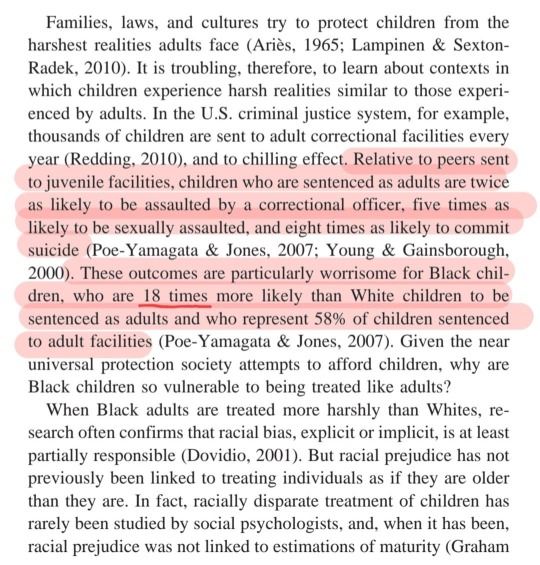

(source)

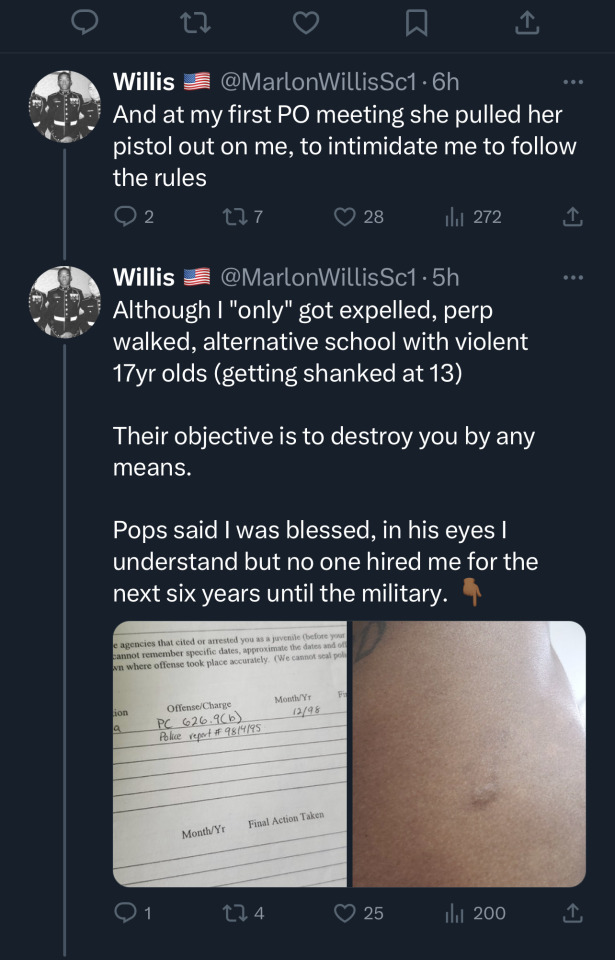
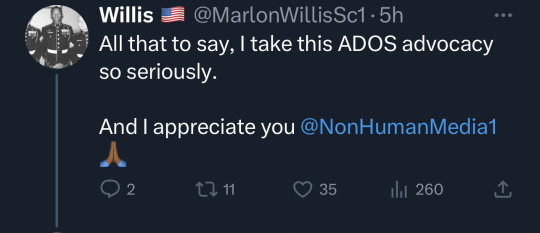
The American criminal “justice” system is deeply racist. From the police, to the jury system, to the prison system.
Mass incarceration laws and the death penalty all target Black and Brown people disproportionately. Politicians who brand themselves as “law-and-order” candidates, or as no nonsense, “tough-on-crime” politicians are fully aware of these structurally racist underpinnings of the U.S. criminal system, and they gladly use law & order as a kind of racist dog whistle: when the question is, “Who are we going to lock up?”the unspoken but understood answer is, “BLACK people!” Especially in, but not limited to, the “former” slave states (aka current Republican states.).
This kind of dog whistle politics (aka “Southern Strategy”) to appeal to conservative white southern voters is not new.
The same is true with how we treat people with drug addictions. America has two completely different views on who is deserving of compassion and who needed to be locked away in prison forever.
And if you’re reading this from a European country, please don’t make the mistake of thinking that your country is somehow different or better. HA! America is a racist country and(!) Europe is every bit as racist against Black and Brown people as anywhere else.
Universally, there is a correlation between who gets the best jobs & housing and skin color; or who gets jailed more and their skin color. These cannot be explained away without acknowledging racism.
Colorism and anti-Blackness are worldwide.
#politics#racism#mass incarceration#two americas#criminalizing blackness#racial stereotypes#southern strategy#dog whistle politics
138 notes
·
View notes
Text
This Salon article by Ian Hanley-Lopez is well worth taking the time to read. Although it was written in Dec. 2013--BEFORE the age of Trump, it was prescient of the continued trajectory of the Republican Party towards a white nationalist agenda. The article describes:
How the indirect racist messaging of "dog whistle politics" began with George Wallace, using the language of being opposed to "arrogant federal authority," and being for "states’ rights," "law and order, running your own schools, [and] protecting property rights." Even though Wallace was a Southern Democrat (and later an Independent) the "dog whistle" strategies he employed were later appropriated by the GOP in the "Southern Strategy."
How the GOP's "Southern Strategy" slowly developed in the 1960s, when Goldwater began to push “states’ rights,” as well as “freedom of association." This strategy over time helped the Republican Party begin to appeal to those white voters who still held overt or covert racial prejudices.
How Kennedy and Johnson, by promoting civil rights legislation, turned the Democrats into the party identified with championing the civil rights of marginalized racial and ethnic groups.
How Richard Nixon fully embraced the "Southern Strategy," through his messaging of being for "law and order," and against the "forced busing" of children (to integrate public schools). As he gradually adopted this strategy, Nixon also turned against one of his own administration's earlier policies (developed by George Romney), which Nixon later derided as the "forced integration of the suburbs."
How, according to Hanley-Lopez, these changes in the racial strategies and policies of the diverging Republican and Democratic parties in the 1960s/early 1970s contributed to "the rise of racially identified parties," with a majority of white voters shifting to the GOP (which became "in fact, though not in name, the White Man's Party"), and the Democratic Party being associated with racial and ethnic minorities (as well as a smaller proportion of white voters, i.e., well-educated whites, especially white women).
[color emphasis of terms, quotes added]

Echoes of Nixon's 1968 campaign ad in one of Trump's 2020 campaign ads
Hanley-Lopez mentions a 1968 Nixon campaign ad that focused on "exploiting the growing panic that equated social protest with social chaos." Above is the video of that 1968 ad: "The First Civil Right." Below is a transcript of the video:
TRANSCRIPT*
(Music with snare drum and dissonant piano chords)
MALE NARRATOR**: It is time for an honest look at the problem of order in the United States. Dissent is a necessary ingredient of change, but in a system of government that provides for peaceful change, there is no cause that justifies resort to violence. Let us recognize that the first civil right of every American is to be free from domestic violence. So I pledge to you, we shall have order in the United States.
[TEXT: THIS TIME VOTE LIKE YOUR WHOLE WORLD DEPENDED ON IT. . .NIXON]
[Color/ emphasis added.]
This 1968 Nixon campaign ad is eerily like at least one Trump 2020 campaign ad, "Abolished," which used some out of context video footage in order to exploit the fears of many white conservative voters regarding the Black Lives Matter protests and the poorly worded "Defund the Police" slogan.
youtube
Below is a transcript of the Trump campaign's 2020 "Abolished" video.
TRANSCRIPT***
[ Phone ringing/ Answering machine beeping/ background music. ]
AUTOMATED FEMALE VOICE: You have reached the 911 police emergency line. Due to defunding of the police department, we're sorry but no one is here to take your call. If you're calling to report a rape, please press 1. To report a murder, press 2. To report a home invasion, press 3. For all other crimes, leave your name and number and someone will get back to you. Our estimated wait time is currently five days. Goodbye.
[ TEXT: Joe Biden's supporters are fighting to defund police departments. Fox News, 6/6/20 | Violent crime has exploded. ABC News, 6/24/20 | You won’t be safe in Joe Biden’s America. |
TRUMP PENCE KEEP AMERICA GREAT 20 ]
TRUMP: I'm Donald J. Trump and I approve this message.
[Color/ emphasis added.]
In conclusion, the barely covert racism in the GOP's political messaging that was so prominent during Trump's administration, and currently in the DeSantis Florida administration (among other GOP administrations) was not new. It was deliberately fostered by Republicans, starting in the 1960s, as they deployed their "Southern Strategy" to woo white voters who still had some overt or covert racial prejudices. The "Southern Strategy" relied on Republicans incorporating into their messaging strategies the kind of covert racist messaging that George Wallace used.
This strategy has unfortunately succeeded all too well.
[edited]
______________
*Transcript source (before layout changes/ edits) of the 1968 Nixon campaign's ad "The First Civil Right,"(alternatively called "Law and Order"): Museum of the Moving Image, The Living Room Candidate: Presidential Campaign Commercials 1952-2012.
**Note that the "male narrator" sounds a lot like Nixon (at least to me).
***The transcript of the Trump campaign's 2020 "Abolished" ad is based on the English auto-generated YouTube transcript, as well as the video text and sounds/music.
#southern strategy#how the gop became the “white man's party”#george wallace#barry goldwater#richard nixon#donald trump#covert racism#dog whistles#nixon's 1968 the “first civil right”/“law and order” political campaign ad#trump's 2020 “abolished” political campaign ad#ian hanley-lopez#salon#youtube video#the living room candidate video
105 notes
·
View notes
Text


the way the atla fandom mocks buddhism constantly I see why this is their fave character. I can’t believe people let this slide even worse defend it and say it’s funny. just a weird bunch
46 notes
·
View notes
Note
Dell Conagher destroys bigots with facts, logic, and God's honest truth, that conservatives love to claim they follow, but would shit themselves, when someone who actually knows what he's talkin' about verbally rips them to shreds. Even though he very much would like to do so literally.
That man will build his own damn bar before he ever goes to one flying a conservative flag. Assigning him the bigoted Southerner stereotype, no matter how loud those types of people are, is an insult to his intelligence, and people living in the South in general.
I don't know every single detail behind the confederate flag. But I do know there are a thousand images of bars to be used as reference, inspiration, or the base for a piece depicting Engie. The people flying it do not deserve any attention, or positive associations with the kind of man who would despise them all.
- Penis Anon.
That and also most southern stereotypes along the lines of "dumb racist/republican hick who lives in a trailer park and dates their cousin" just doesn't make sense for him in general. And the reason why is obvious by simply looking at him.
The entire point of Dell's characterization is that he subverts the stereotypes that others outside of the south have for southerners. He subverts the "dumb hick" stereotype by having 11 phds and canonically having a favorite equation. He subverts the concept of "southern hospitality" by him having a god complex and using that said idea as a facade to hide his unhinged behavior.
Literally just analyzing the 'Meet the Engineer" is all someone has to do to understand him (since the shorts are also like a tl;dr of the mercs' personalities).
Not only is it offensive and out of character, it's also just lazy.
"Yeah let's slap this stereotype on him! most people in the south are like anyways" - said by someone who doesn't even live in the south
The only reason someone would headcanon engineer as being racist or think positively of the confederates (the flag or in general), is because they think most southerners are like that; regardless of if it's actually true. And it doesn't do anything except hurt the black southerners that are still forced to feel the historical effects and impact from the confederates constantly.
#long post#damn i wrote a lot here#i know the post is very sensitive and heavy and i apologize for that#take a shot everytime i say any variation of “southerner” “south” and “stereotype”. your liver will hate you#/j (please dont actually do this)#also if given the opportunity engineer would probably kill someone with a confederate flag#tf2#tf2 engineer#engineer tf2#[just me yapping]#proships dni#incest mention tw#racism tw
8 notes
·
View notes
Text
Follow-up about why I dislike Ethel Cain tiktok fans: the other point I wanted to make in regards to stereotyping southerners was that I hate that audio that is like “are you wearing that (camo jacket) in a Ethel Cain vinyl way or in a conservative way?” I detest this audio because it condemns the aesthetics of the rural working class mainly southern working class. I constantly see these fans dressed in camo and cowboy boots talking about how they aren’t “rednecks” but instead Daughters of Cain. I’m all for reclamation of rural/southern aesthetics as a queer person. I indulge in this practice as well. However, the example I provided assumes that all southerners can be typecasted as ignorant and categorized as bigots based upon the way they dress.
It gives people the solace of seeing a blue collar worker in public and condemning them to assumptions that they are right-wing bigots cause they choose to wear camo, boots, americana, Marlboro apparel, or distressed work clothes.
#redneck also isn’t a bad term#unlearn your classism before engaging in queer spaces#anti-southern rhetoric from liberals is just racism and classism#all of my perspective comes from being a rural queer leftist in the south who interacts with their community#okay to rb
106 notes
·
View notes